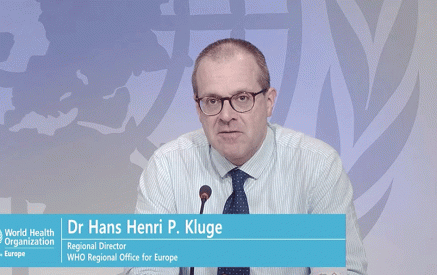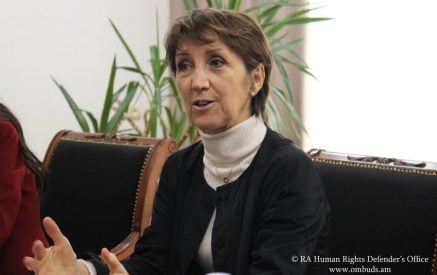Ara V.Papyan
AIISA associate fellow on International Trade, Investment Law and EU Law
Ph.D. candidate at the University of Lausanne (Switzerland)
As the world continues facing Severe Acute Respiratory Syndrome Coronavirus-2 (SARS-CoV-2 or COVID-19), there are ever intensifying discussions on the reasons why we have all arrived at such a situation. It has become trending to criticize World Health Organization (WHO) or Governments for inaction or late action, which to some extent, is justified criticism. However, there were few analyses on whether the International Health Regulations of 2005 (IHR 2005), based on which WHO and countries are acting, has contributed to the extent of the spread of the disease.
Before turning to the legal gaps of IHR 2005 it is necessary to turn to several important general considerations. The second part of the article will explore the legal gaps, which have led to the development of such a situation.
PART 1: General Considerations
IT IS NOT THE FIRST TIME WHEN THE WORLD FACES CORONAVIRUSES
Read also
Coronaviruses have all the time been around us, sometimes causing mild illnesses. However, in addition to COVID-19, there were two other coronaviruses, which have caused serious concerns. One of them is Middle East Respiratory Syndrome (MERS) caused by Middle East Respiratory Syndrome Coronavirus (MERS CoV). For the first time MERS was reported by the health authorities of Saudi Arabia in September 2012 and further epidemiological investigation revealed that the first case appeared in Jordan in April 2012. Outside of the Arabian Peninsula in 2015, MERS was detected in the Republic of Korea as well. According to the Center for Diseases Prevention and Control of United States MERS may affect people at all age groups (1-99 years old) and 3-4 people out of 10 affected by MERS died as a result of the development of severe respiratory illness. Based on the data provided by WHO, as of June 2019, there were 2249 cases with a death rate of 34.5%.
Yet another coronavirus, which has caused serious concerns, was Severe Acute Respiratory Syndrome Coronavirus (SARS), which was detected in 2003 in China. It affected more than 8000 people in 26 countries and the transmission chain was broken in 8 months, even though China had concealed the existence of the disease from the society and WHO. Emergence of SARS in 2003 facilitated the revision process of International Health Regulations, which was launched in 1995 and was moving forward slowly. After the adoption of IHR-2005 SARS 2003 was listed among diseases such as Smallpox, Wild Polio, and Influenza, which are considered by WHO as critical diseases. The appearance of a single (one) case of these diseases is considered as “unusual” or “unexpected” with serious public health impact. This would mean that one case of emergence of SARS 2003 may lead to an immediate declaration of an international health emergency (Public Health Emergency of International Concern—PHEIC).
There are number of similarities between COVID-19 and SARS 2003, even though these diseases, as it is claimed by scientists, are different ones. An article published on March 5, 2020 in one of the most reputable journals on infectious diseases—“The Lancet”, indicated that the whole genome of COVID-19 has 86% similarity with SARS CoV of 2003, as well as highlights a number of differences between these diseases. Both viruses have allegedly been transmitted to humans by bats.
Taking into consideration that coronaviruses may be of different levels of danger and even be included in the critical list of diseases and that information about COVID-19 disease will continuously evolve, the highest level of cautiousness shall be devoted to it both from the societies and the Governments. This is especially the case when States have started easing the nation-wide lockdowns.
WHO IS DECLARING PHEIC IN EXCEPTIONAL CASES
Before COVID-19 was declared as Pandemic on March 11, 2020 WHO had also issued its highest level of alert on January 31, 2020—Public Health Emergency of International Concern (PHEIC). It needs to be considered that WHO is not declaring PHEIC in the case of all diseases. It may annually receive hundreds or thousands of notifications from States on various diseases and there have been only 6 diseases since 2005, which satisfied the criteria provided in IHR-2005 to be declared as PHEIC. Those diseases are INFLUENZA (A) H1 N1 (Swine Influenza), Ebola in 2014, Wild Polio in 2014, Zika in 2016, Ebola in the Democratic Republic of Kongo in 2019.
In case of COVID-19 the Director-General of WHO has convened three meetings of Emergency Committee on January 22, January 23, and January 31. Without the recommendation of the Emergency Committee the Director-General does not have the right to declare PHEIC. During January 22 meeting the opinions of the members of the Committee were divided and the Emergency Committee could not decide by voting. During the next meeting the Emergency Committee concluded that the criteria of declaring PHEIC were not met. However, the Emergency Committee, after receiving sufficient scientific justification to declare PHEIC, advised the Director General to declare PHEIC.
Declaration of International Health Emergency by WHO is a politically, economically, and socially sensitive matter, since it leads to panic, economic challenges, and limitations of movement of people, as well as to other challenges. That is the reason why WHO does not resort to such declaration lightly. In addition to this, not every disease passes the threshold to be declared as an international health emergency. When declared, societies and governments shall start preparations to counter the diseases.
DECLARATION OF PHEIC IS NOT A CALL TO CLOSE ALL BORDERS AND LOCK SOCIETIES
Declaration of PHEIC is an act of information, which alarms the global community on public health risk to other States through the international spread of the disease, which potentially requires coordinated international response. After this declaration WHO is acquiring emergency powers to issue temporary recommendations through which it coordinates the response of the States and the States shall prepare to encounter the disease by following those recommendations.
However, immediately after the declaration of PHEIC, the States are proceeding to the closure of borders. The Republic of Armenia, immediately after the declaration of PHEIC on January 31, canceled a visa-free regime with China on January 31, 2020, and on February 25, when cases have been detected in Iran, the Government has blocked the borders with Iran. Even though these actions have contravened the instructions of WHO and violated some provisions of IHR-2005, they were justified actions.
WHO is not only issuing travel recommendations, which at the moment may be considered as unjustified. It also provides technical recommendations, which in case of COVID-19 were in large volumes. Those recommendations and the assistance provided to the States is implemented by engaging the resources of WHO and its partner institutions, such as Global Outbreak Alert and Response Network (GOARN), which has 250 technical institutions in its network with their staff, 2500 experts in 90 countries. The experts engaged in this network are providing remote assistance to affected States and have already deployed 43 emergency response teams to different States in the course of development of the Pandemic.
WHO is implementing large-scale projects to assists the States and unjustified travel recommendations shall not be a cause to disregard other recommendations or deal with them with skepticism. No State has enough capacity to implement activities or research, which is done by GOARN network and WHO. The actions of the States and WHO are based on the information available at a time, and when more information is becoming available, they are taking additional actions.
NEW DISEASES ARE UNAVOIDABLE REALITY
The world has faced epidemics and pandemics for numerous times. In past cholera, plague, smallpox, poliomyelitis, influenza, malaria, and tuberculosis have taken the lives of millions of people. Some of these diseases were taken under control or eradicated due to improved public sanitation, personal hygiene, due to enhanced control over vector-borne diseases and availability of vaccines. We may recall smallpox, which has been eradicated, or poliomyelitis which is in the process of eradication. However, after the success in controlling or eradicating some, let’s conditionally call them “traditional diseases”, another factor came into play—“emerging diseases” or “new diseases”. Zika, Ebola, HIV/AIDS, Avian Influenza, Severe Acute Respiratory Syndrome coronavirus of 2003 (SARS CoV), Swine Influenza are examples of diseases, which at a time were considered as new ones. Thus, the emergence of new diseases is not something one may be surprised at. On the contrary, it is a matter, for which the States and societies shall always be prepared.
There are numerous research papers, which indicate the reasons for the emergence of new diseases. Amongst those factors are human demographics and behavior, technology and industry, economic development and land use, international travel and commerce, microbial adaptation and change, and breakdown of public health measures (Bulger, 1992). Another research paper, in addition to these factors, adds human susceptibility to infection, climate and weather, changing ecosystems, poverty and social inequality, war and famine, lack of political will (Smolinski et al, 2003). We may look at some examples. Changes in the environment, such as deforestation or global warming may increase the frequency of contact with a natural host carrying infection and, therefore, increase our chances of encountering microorganisms previously unknown to humans. There are a number of examples of diseases associated with activities like food-handling practices, consumption of wild meat. As it was mentioned in the research, there may be a number of ecological changes, which provide new opportunities to emerge and transmit to human populations, while the increased movement of people and goods is playing the role of transmitting those pathogens to different corners of the world.
STATES SHALL BE PREPARED TO COUNTER NEW DISEASES
All countries in the world are struggling to establish additional capacities to deal with COVID-19, while they should have created those capacities by 2012, since they had undertaken obligations under International Health Regulations (2005). This deadline was extended several times due to non-compliance on the part of the States. During the COVID-19 Pandemic the Governments needed to close the gaps, which they had left open for many years and health authorities are stretching well beyond their actual capabilities. Most recent research on capacities of 182 States suggests that despite improvements in the establishment of capacities to detect, prevent and control infectious diseases, there is a significant gap and non-compliance on the part of the States in 2020- 8 years afterward the first deadline. The States, which had established capacities before the emergence of COVID-19 have also found themselves in a very complicated situation: a high rate of over hospitalization collapsed the health infrastructure (for example in Spain, Italy, United Kingdom). This situation may have resulted from the delayed reaction of the States to declare Public Health Emergency of International Concern (PHEIC or International Health Emergency), intensive movement of people, and for other reasons.
In 2011 a Review Committee, composed of world-leading experts in the field of public health, after analyzing the global response and operation of International Health Regulations in case of Influenza (A) H1 N1 (Swine Flu) Pandemic has concluded that the world is ill-prepared to respond to severe influenza pandemic or to any similarly, global, sustained and threatening public health emergency, and that unavoidable reality is that tens of millions of people would be at risk of dying in a severe pandemic and stated that the fundamental gap between the global need and the global capacity must be closed. This gap does not seem to be closed as of now. In addition to accelerating the establishment of core capacities, the Review Committee advised establishing a more extensive global, public health reserve workforce, which may be deployed at any country of the world to assist the national governments, as well as other highly important recommendations (totally 15 recommendations).
However, the lessons were not learned, and another Review Committee in 2016, convened to analyze the global response and the operation of IHR in case of Ebola outbreak in 2014, which went out of control at a time, mentioned in its report that the failures in the response to Ebola mirrored the errors of Swine Flu response and urged to implement earlier recommendations and made 12 additional recommendations to both WHO and its Member States. The Review Committee observed that by 2016 only 65 out of 193 States declared that they have met their minimum core capacities, 84 States requested an additional two years of the implementation deadline, and 44 States have not communicated their intentions to WHO. Failure to comply with core capacities establishment obligations resulted from lack of political or institutional will, lack of financial, human and logistical resources, as well as lack of understanding and awareness of IHR.
Review Committee urged the Governments to prioritize in 8 areas: 1) surveillance, risk assessment and response; 2) zoonosis and collaboration with the animal health sector; 3) laboratories, infection prevention and control; 4) risk communication; 5) regional planning and preparedness; 6) generic public health emergency capability; and 7) monitoring and evaluation of the ongoing capacity building. All of these were considered as essential capacities each State should have.
One example of insufficient core capacity could be risk communication, which was not the strongest part of the States during the COVID-19 Pandemic. The social networks and alternative news sources managed to spread huge amounts of disinformation, such as putting forward conspiracy theories or comparing the disease to a common cold, which created an environment of “false security” for some people, who put others in danger. Sometimes there are also opinions expressed by government officials, which may also have had a detrimental effect on risk perceptions in society. As was mentioned by an author, the COVID-19 pandemic is not only viral but is also digital and the flow of information has reached unprecedented scales in human history. The massive flow of unchecked information, as well as the popularity of conspiracy theories, is demonstrating that the core capacity element—risk communication, is not well-established within the countries. If the public does not maintain trust in governmental organizations, they are less likely to follow any medical advice or procedure, or else, with the circulation of conspiracy theories, people may be more likely to develop negative attitudes toward an interpretation of preventive measures, considering them as unnecessary. Thus, the Governments shall all the time improve their risk communication policies to reach every citizen.
LIMITED ACTIONS ARE AVAILABLE TO COUNTER NEW DISEASES: SOCIETIES SHALL ASSIST THE GOVERNMENTS THROUGH COMPLIANCE
The control of new infectious diseases, against which no medicaments are available, is a very complicated task. World Health Organization (WHO) and its Member States are working in the environment of uncertainty and need to collect information, make predictions and recommendations and undertake measures, which in some cases may not be effective and may need to be revised when more information is becoming available. In case of absence of medicaments, the States have no choice but to take so-called “public health countermeasures”, such as disease surveillance, hygienic measures such as community hygiene and hospital infection control, social distancing, travel restrictions, quarantine and case isolation, contact tracing and other activities. Public health measures are most frequently called “non-pharmaceutical methods of intervention” and discussions on the forms of such measures and their effectiveness are abundant in the literature. These interventions are not capable of completely stopping the transmission of the virus but may slow the epidemic or pandemic and can buy time for the development of medical countermeasures, such as development of the vaccine, while also helping to ensure that the health care system does not get overwhelmed. The major problem with these methods is the degree of enforcement in the States and the social responsibility of the people.
The COVID-19 also falls within the category of new infectious diseases, for which no vaccine is yet available and every country in the world is taking non-pharmaceutical methods of intervention. The non-pharmaceutical measures of intervention in case of the COVID-19 are most radical ones: complete lockdowns of States. It remains questionable for how long the States will be able to sustain economic consequences of these lockdowns and keep economies close. The financial resources of the States are vanishing, while the disease continues to spread.
When the restrictions are eased, citizens and legal entities shall closely follow the recommendations issued by the Government to keep the infection under control.
CONCLUSION REMARKS
As all States in the world, Armenia has limited actions to undertake, to control the spread of the disease—public health countermeasures. These countermeasures will not completely stop the transmission of the disease but may buy time. The State shall take strict measures to ensure compliance with limitations such as social distancing, quarantine, isolation, self-isolation and other measures. At the same time, the society shall demonstrate exceptional social responsibility and follow the instructions of the Government. Even though Armenia on some aspect was prepared to deal with the spread of infectious diseases, there are shortcomings, too. Countries are annually reporting on the implementation of core capacities requirements and when looking at Armenia’s reporting, in 2018 the Government assessed that its financing mechanisms and funds for the timely response to public health emergencies was 60 out of 100 points, planning for emergency preparedness and response mechanism was 60 out of 100 points, capacity for infection prevention and control and chemical and radiation contamination was 60 points out of 100, case management capacity was 60 points out of 100.
Democracy, Security and Foreign Policy programme « (NED)
The Armenian Institute of International and Security Affairs (AIISA)





























































